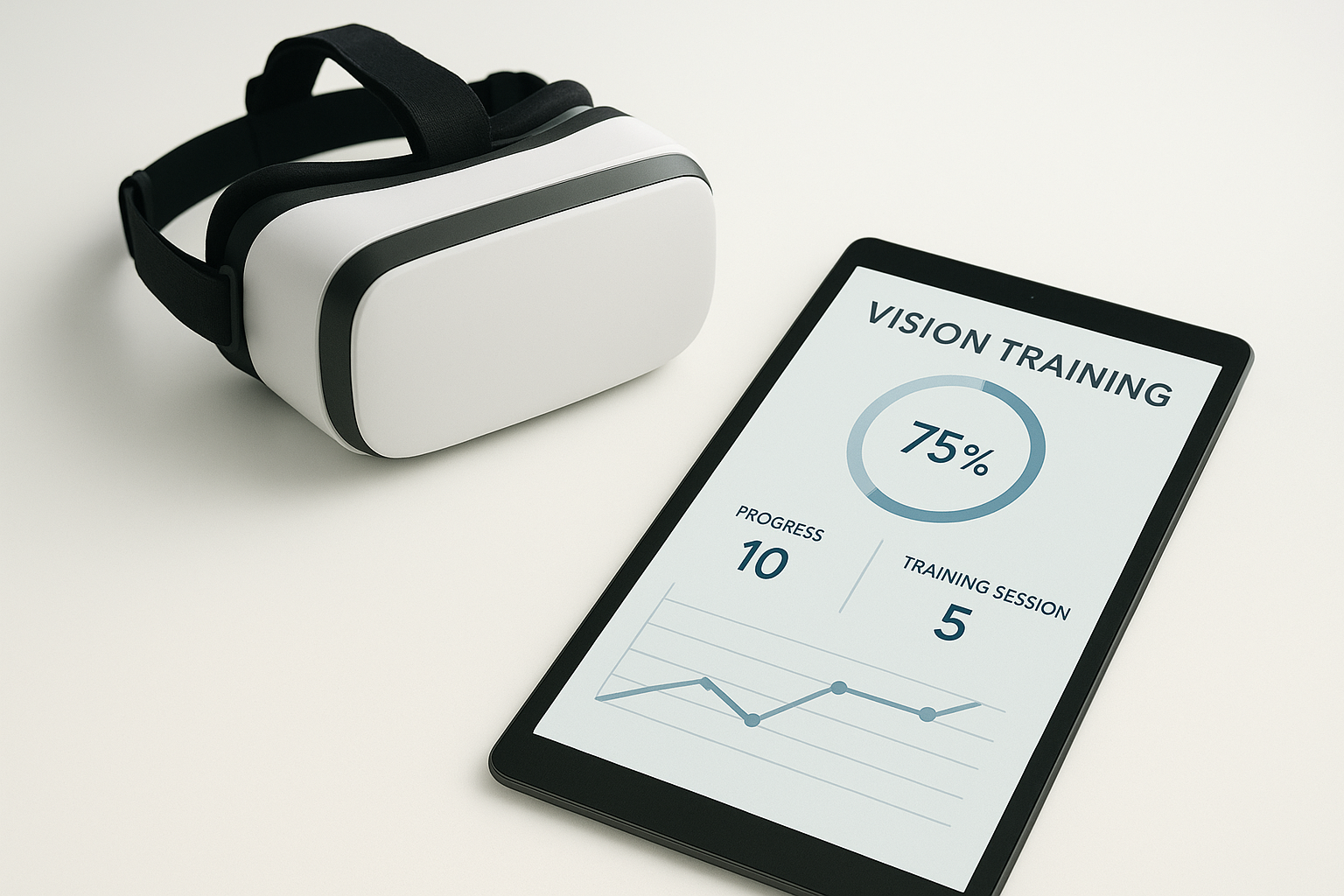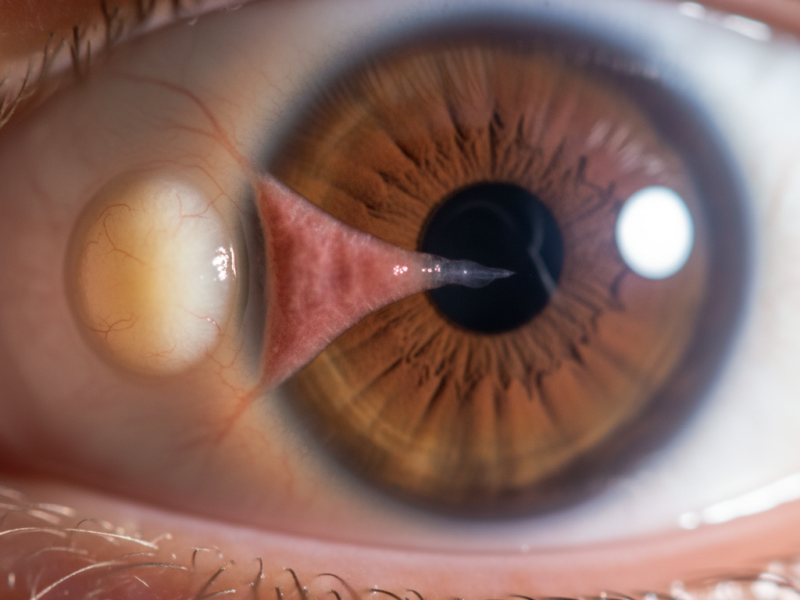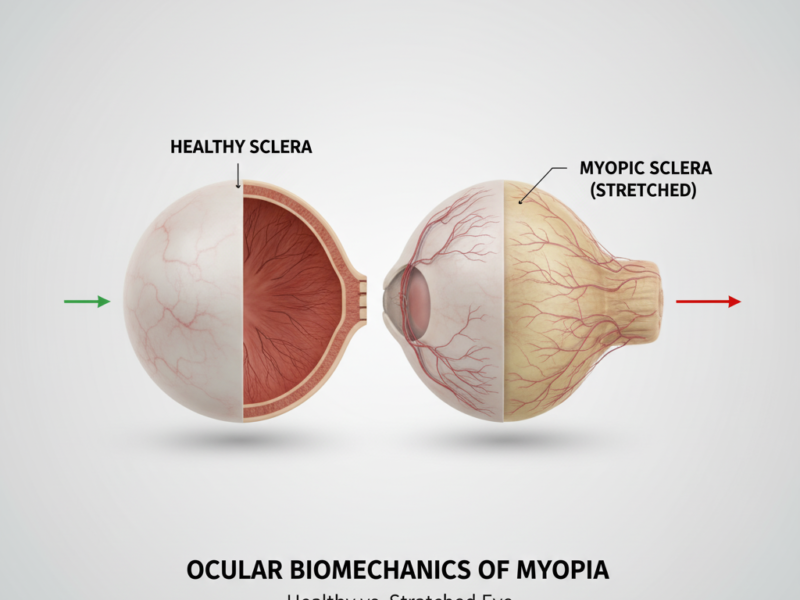Introduction
We live in a stacked, attention-heavy world: we read on screens, we track fast objects on video, we demand split-second visual decisions from our eyes and brain. That rising visual load is why neuro-visual training — exercises that target the brain’s handling of visual information — is gaining traction. But can these brain exercises actually improve eyesight, or are they just clever marketing?
In this article we’ll dig into the science, practical exercises, modern devices and apps, real-world evidence, and a step-by-step 8-week program you can try at home. If you want to improve focus, reaction time, eye tracking, or reduce digital eye strain using brain-centric methods rather than (or alongside) lenses and surgery — read on. This is evidence-minded, practical, and written for people who want to take action.
1) What exactly is neuro-visual training?
Neuro-visual training (NVT) refers to exercises and protocols designed to strengthen the brain pathways that process visual input — not just the eye muscles that move the eyeball. Think of vision as a pipeline: the eyes capture images, but the brain organizes, filters, interprets, and acts on them. NVT targets cortical processing (visual attention, saccades, smooth pursuit, binocular coordination, contrast sensitivity, visual memory and reaction timing).
Key components:
- Oculomotor control — voluntary eye movements (saccades, pursuits).
- Accommodation flexibility — how quickly eyes switch focus between distances.
- Binocular coordination — eyes working together to form a single image (convergence / divergence training).
- Visual processing speed & decision — how fast the brain recognizes and responds.
- Higher visual skills — visual memory, spatial awareness, and attention.
Why the brain? Because many visual performance issues (slow focus shifts, poor tracking, difficulty with crowded text) are processing problems more than optical refractive errors. NVT aims to adapt and strengthen neural circuits using repetition, progressively harder tasks, and feedback — the same principles used in physical training or cognitive training.
Did you know?
Visual training programs have been used in sports for decades — pro athletes train tracking and contrast sensitivity to gain milliseconds in reaction time. Now similar principles are shifting into consumer vision training.
2) The evidence: what research says
This is the part people want first: is there proof?
Moderate evidence supports improvements in specific visual functions with training. Peer-reviewed studies show benefits for:
- Strabismus and convergence insufficiency: Vision therapy (targeted exercises) is effective for convergence insufficiency; randomized trials support structured therapy over home leaflet exercises.
- Amblyopia (lazy eye): Pediatric vision therapy combined with patching improves outcomes compared to patching alone in some studies.
- Oculomotor dysfunction: Targeted oculomotor training improves saccadic accuracy and reading efficiency for people with oculomotor deficits.
- Sports vision: Training can improve reaction time and processing speed, though translation to on-field performance varies.
But be cautious: blanket claims that training “reverses myopia” or eliminates need for corrective lenses are not supported. Many highest-quality studies are specific (e.g., convergence insufficiency) rather than general “improve eyesight for everyone” claims.
Important caveats:
- Study quality varies. Better results are in controlled, clinician-supervised programs.
- Placebo & engagement effects matter. Simply doing a focused activity can temporarily improve performance.
- Duration & adherence: Gains often depend on regular practice (weeks to months).
Bottom line: NVT shows real, useful results for many functional visual deficits and skill improvements — especially when personalized, measured, and supervised. For general refractive errors, evidence for permanent correction is lacking.
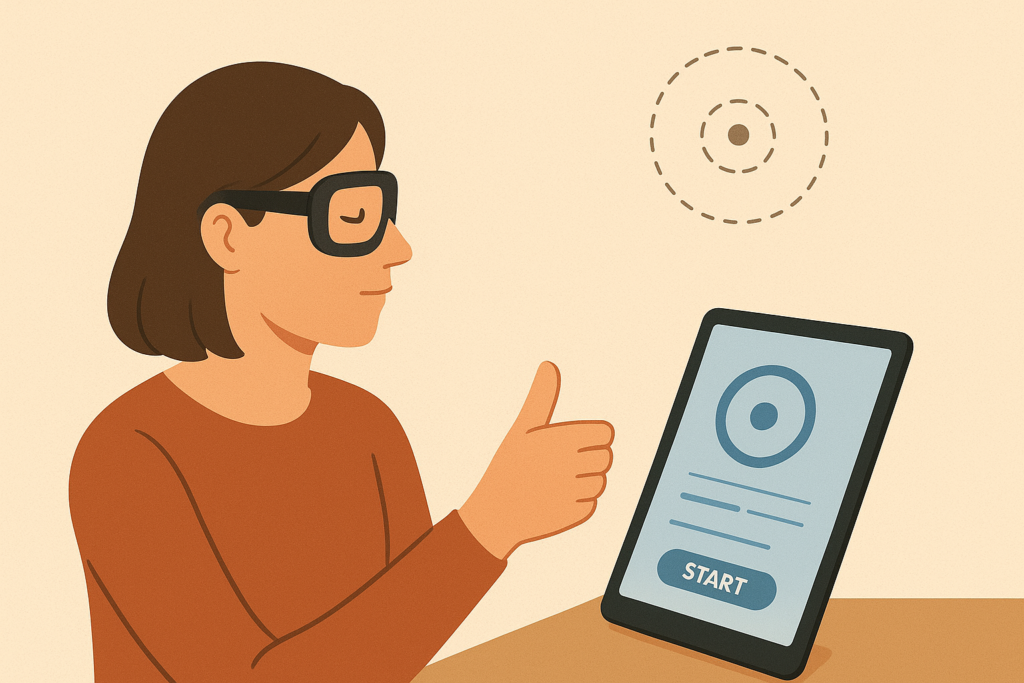
3) Types of neuro-visual training (what exists)
There are several approaches — from low-tech to high-tech:
A. Low-tech, clinician-guided exercises
- Pencil push-ups (convergence training)
- Saccade charts (rapid eye movement to targets)
- Brock string (binocular coordination)
These are inexpensive, often prescribed by optometrists or vision therapists.
B. Software/apps (home programs)
- Apps target reaction time, contrast sensitivity, peripheral awareness, and accommodation drills. Example tasks: identify briefly shown letters, track moving dots, or perform near-far toggles with timed feedback. Good apps provide difficulty progression and data logging.
C. Perceptual learning exercises
- Repeated exposure to degraded stimuli (e.g., low contrast letters) trains the visual cortex to better process weak signals. Research indicates perceptual learning can improve contrast sensitivity and functional vision.
D. Hardware devices & wearables
- Focus training goggles (strobe or occlusion devices) that enforce alternating input.
- Light-based stimulators for contrast/retina stimulation.
- VR headsets offering immersive, controlled visual tasks (tracking, depth cues, peripheral awareness). VR is exciting because it precisely controls stimuli and measures performance.
E. Combined protocols
- Most clinical programs combine several modalities — eye exercises, perceptual tasks, and lifestyle interventions (sleep, nutrition, ergonomics).
4) Who benefits most (target populations)
Neuro-visual training is not a “one size fits all.” Best candidates:
- People with convergence insufficiency (difficulty reading, double vision at near).
- Children with amblyopia or binocular dysfunction (when combined with standard therapy).
- Individuals with oculomotor deficits after concussion or head injury.
- Athletes seeking improved tracking and reaction time.
- Professionals requiring fast visual decisions (pilots, drivers, esports players).
Less likely to benefit:
- People whose only problem is uncorrected refractive error (i.e., need glasses for myopia) — they should get the proper optical correction first.
- Those expecting miracle reversal of structural ocular diseases (glaucoma, macular degeneration) — NVT cannot restore lost retinal tissue.
Clinical pathways often combine optical correction (glasses/contacts), medical management (if required), and training to maximize function.
Did you know?
Perceptual learning studies have shown measurable improvements in contrast sensitivity after just a few weeks of targeted practice — even in adults, where plasticity was once thought limited.
5) Practical neuro-visual exercises you can try (step-by-step)
Below are clinician-informed, safe exercises — do them 5–10 minutes/day unless otherwise advised. If you have eye pain, double vision that persists, or neurological disease, consult a specialist.
Exercise A — Saccade training (speed & accuracy)
- Post sticky notes with single letters across a wall.
- Fixate center, then move eyes quickly to read a random letter and return.
- Do sets of 20 saccades, alternating vertical & horizontal.
Goal: improve saccade precision and reading economy.
Exercise B — Smooth pursuit (tracking)
- Hold a small object (pen) at arm’s length.
- Slowly move left → right while following the pen smoothly with your eyes (no head movement).
- 8–10 repetitions.
Goal: improve pursuit and reduce jerky tracking.
Exercise C — Near-Far focus toggles (accommodation flexibility)
- Hold thumb 20–30 cm away; focus for 10 sec.
- Shift focus to a distant object (6+ meters) for 10 sec.
- Repeat 10 times.
Goal: speed accommodation changes and reduce focusing fatigue.
Exercise D — Brock string (binocular coordination)
- Tie colored beads on a string (~1.5–2 m).
- Hold one end to nose, beads at varying distances.
- Focus on each bead; you should see two strings crossing at the bead if working properly.
Goal: improve convergence/divergence control.
Exercise E — Contrast/Perceptual drills (app-based)
- Use an app that presents low-contrast letters or brief images.
- Identify them and get immediate feedback; difficulty ramps up automatically.
Goal: train the brain to extract useful information from poor signals.
Safety notes: stop if you have severe double vision, eye pain, or persistent visual disturbances and consult your provider.
6) Devices & apps — what to look for
If you plan to invest in devices or subscriptions, choose those with:
- Objective measurement (logs, performance metrics).
- Progression & personalization (difficulty adjusts with your performance).
- Clinician backing (used in studies or recommended by optometrists).
- Data export & reporting (useful if working with a therapist).
Popular categories:
- VR training platforms — immersive, controlled environments for depth perception & tracking.
- Tablet apps — convenient and cheap; look for validated apps.
- Wearables/goggles — more expensive but simulate real-world occlusion and pacing.
Cost-benefit tip: start with good apps and clinician guidance before buying hardware.
7) Measuring progress — tests & metrics
Track improvements objectively:
- Near point of convergence (NPC) — how close you can converge without double vision.
- Saccadic tracking tests — letters read per minute, error rate.
- Contrast sensitivity — standardized charts or app tests.
- Reaction time & decision accuracy — e.g., sports vision tests.
- Subjective scales — symptom questionnaires for visual fatigue.
Collect baseline data, repeat every 4 weeks, and adjust training based on results.
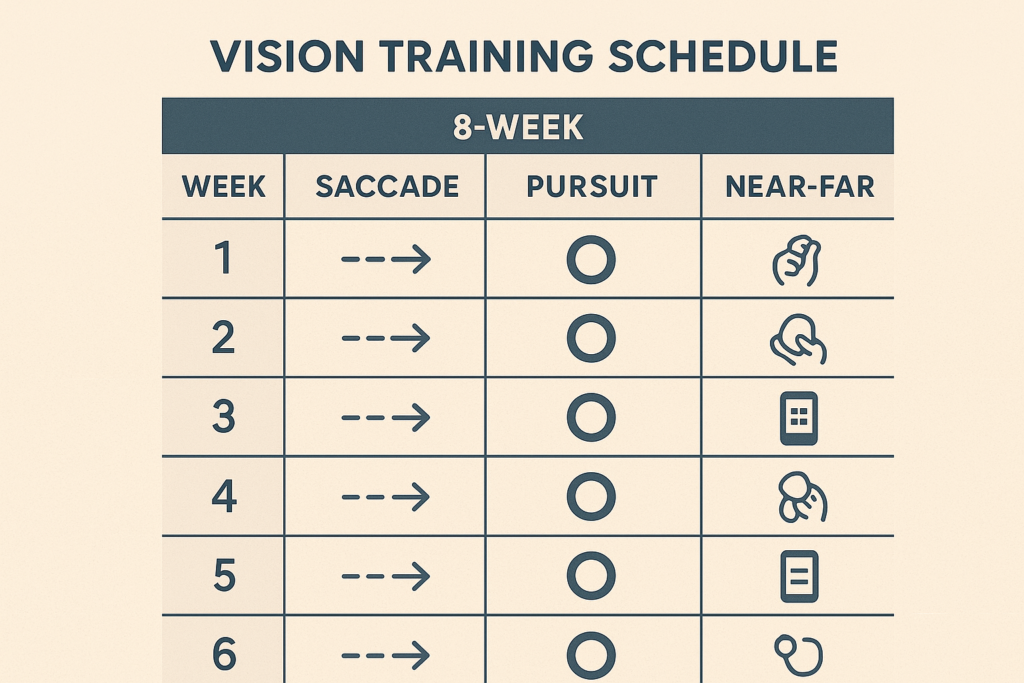
8) Sample 8-Week Training Plan (practical, day-by-day structure)
Principles: progressive overload (task gets harder), variety (avoid plateau), rest days, and measurement.
Weeks 1–2 — Foundation (daily ~10 min)
- 20-20-20 rule (work integrated).
- Saccade chart: 5 minutes.
- Near-far toggle: 5 minutes.
- Log symptoms & performance.
Weeks 3–4 — Build (daily ~12–15 min)
- Add smooth pursuit drills (5 min).
- Increase saccade sets & speed.
- App perceptual drill: 5–8 minutes.
Weeks 5–6 — Intensify (daily ~15–20 min)
- Add Brock string convergence practice (5 min).
- Increase app difficulty & VR short sessions (if available).
- Twice-weekly longer session (20–25 min).
Weeks 7–8 — Consolidate (daily ~10–15 min)
- Focus on weakest skills identified by tests.
- Re-run baseline tests (NPC, contrast) and compare.
- Create maintenance schedule (3×/week).
Notes: adapt schedule for kids (shorter, playful sessions) and for concussion patients (clinician oversight).
9) Pitfalls & when to see a professional
- Don’t expect spectacle-free life if you’re nearsighted; NVT supplements, not replaces, optical correction.
- Avoid overtraining — headaches, nausea or persistent diplopia require stopping.
- Red flags: sudden vision loss, flashes, drooping face — seek emergency care.
- Concussion/post-stroke patients should always train under rehab specialists.
Frequently Asked Questions (FAQ)
Q1: Can neuro-visual training eliminate the need for glasses?
A: No — NVT improves visual performance (tracking, focus speed) but does not permanently change refractive error like myopia. Glasses/contact lenses remain essential for optical correction.
Q2: How long before I see results?
A: Many people notice subjective improvements in 4–6 weeks with consistent daily practice; objective measures often require 6–12 weeks.
Q3: Is neuro-visual training safe for children?
A: Yes when supervised appropriately. Programs for amblyopia and convergence insufficiency are established components of pediatric eye care.
Q4: Can NVT help after a concussion?
A: It can. Oculomotor and vestibular rehabilitation are part of concussion care; always work with a specialist.
Q5: Which is better — app or clinic?
A: Both have roles. Clinician-supervised programs offer tailored guidance; apps are great for maintenance and accessibility. A hybrid model yields best outcomes.
Q6: What are common side effects?
A: Temporary headache, fatigue, or mild nausea in some users — reduce intensity or pause if these occur.
Conclusion
Neuro-visual training sits at the intersection of neuroscience, optometry, and practical training. It isn’t a magic cure for optical errors, but it is a powerful way to improve functional vision: faster focus changes, better tracking, improved reading efficiency, and reduced strain. The strongest outcomes come from targeted, measurable programs overseen by clinicians — but motivated individuals can get meaningful benefits with well-designed apps and consistent practice.
If you’re seeing performance plateaus in work, reading, sports, or recovery after injury, neuro-visual training is worth exploring. Start with baseline testing, choose validated tools, follow a progressive plan (like the 8-week program above), and measure results. Little daily habits compound: a few focused minutes a day can translate into clearer, faster, and more comfortable vision.

